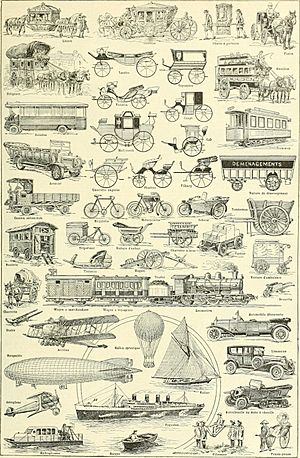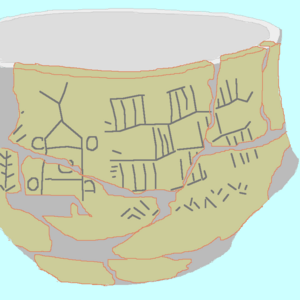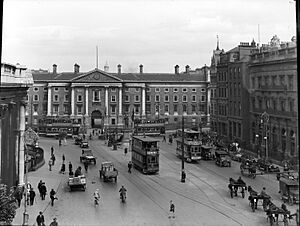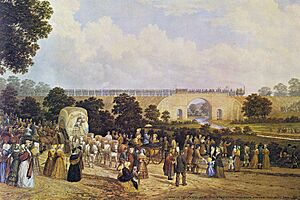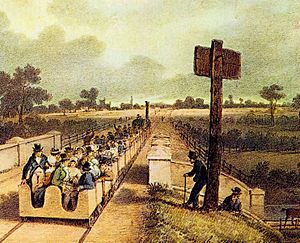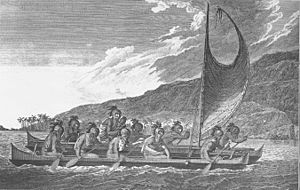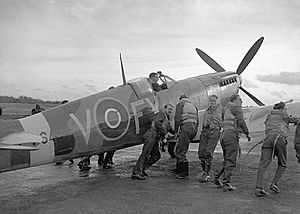History of transport facts for kids
The history of transport is all about new inventions and ideas. As technology got better, people could travel further and explore more places. This helped them spread their influence over bigger areas. Even long ago, simple tools like skis and snowshoes helped people go longer distances. When new discoveries were used for travel, journeys became faster. It also became easier to move more and heavier goods. Today, scientists are still working to make transport cheaper and more efficient.
Global trade was a big reason for improvements in transportation long ago. From the 1500s, there was a single world economy with different parts of the world making different things. The buying and selling of clothes, silver, gold, spices, and fancy items across Afro-Eurasia and later the Americas led to new ways of travel on land and sea.
Contents
Land Travel: Roads and Rails
How Roads Changed Over Time
The very first paths were made by people carrying things. These paths often followed animal trails. Where many people walked, natural tracks formed. When people started taming animals like horses, oxen, and donkeys, these animals also helped create paths. As trade grew, paths were often made flatter or wider for animals. Later, people invented the travois, which was a frame used to drag heavy loads.
Wheeled vehicles pulled by animals probably appeared in the ancient Near East around 4,000 or 5,000 BC. They then spread to Europe and India around 4,000 BC, and to China around 1200 BC. The Romans needed good roads to control their large empire. They built famous Roman roads that were very strong and well-made.
During the Industrial Revolution, John Loudon McAdam designed the first modern highways. He used cheap materials like soil and crushed stone. These roads were built a bit higher than the land around them so water would drain off.
When cars became popular, starting in Germany in 1886 and in the U.S. with Ford's Model T in 1908, better roads were needed. Hard-surfaced roads helped stop washouts, mud, and dust. Early roads in cities used cobblestones or wood. In the early 1900s, tar-bound macadam (tarmac) and concrete became common. In 1902, Radcliffe Road in Nottingham became the world's first tarmac road.
The Story of Rail Transport
Rail transport began almost 500 years ago. Early systems used people or horses to pull carts on wooden or stone tracks. These were often used to move coal from mines to rivers. Flanged wheels, which have a rim to keep them on the track, ran on these rails. Cast iron plates were used as rails from the 1760s. Later, stronger wrought iron rails were introduced.
The first public railway for passengers opened in 1807. It was the Swansea and Mumbles Railway at Oystermouth, using horse-drawn carriages. In 1802, Richard Trevithick built the first steam locomotive to run on smooth rails. He was an engineer from Cornwall, England. He showed his invention in Merthyr Tydfil, Wales.
Trevithick had some ups and downs. His "Puffing Devil" steam locomotive was a success in 1802. But a disaster in 1803, where four men died from an engine explosion, almost stopped his work. His rivals used this to try and stop high-pressure steam engines.
However, Trevithick's "Penydarren locomotive" made history. It was the first full-size working railway steam locomotive. A bet between Trevithick's supporter, Samuel Homfray, and Richard Crawshay led to its big test. Homfray bet 500 guineas that the locomotive could carry ten tons of iron. It had to go from the Pendydarren Ironworks to Abercynon, almost ten miles away.
Trevithick's locomotive finished the trip in just over four hours. This proved that locomotives could be strong and reliable. Sadly, Trevithick never got the recognition he deserved and died poor in 1833.
Modern Trains
Modern rail systems first appeared in England in the 1820s. Matthew Murray showed that the steam engine could work in 1812. His "Salamanca" was the first locomotive with two cylinders.
George Stephenson, known as the "father of railways," built many experimental locomotives. From 1814 to 1826, he made 16 different trains. His last one, the "Killingworth Billy," ran until 1881. Stephenson also built the first railway between two major cities, Liverpool and Manchester, which opened in 1830.
These steam locomotive systems were the first successful way to move things by machine on land. They remained the main form of land transport for the next 100 years. The Stockton and Darlington Railway, opened in 1825, was the first in Great Britain. It mainly hauled minerals. The Liverpool and Manchester Railway, opened in 1830, was the first modern railway. It carried both passengers and goods. By 1870, Britain had about 13,500 miles (21,700 km) of railway.
In 1879, electric locomotives started to become popular in Germany. Werner von Siemens showed the first experimental electric passenger train. It carried about 90,000 people. It worked by getting electricity from an insulated third rail. In 1881, Siemens built the world's first electric tram line in Berlin. Other cities like Brighton and Vienna followed this trend in 1883.
Diesel Locomotives Dr. Rudolf Diesel developed a new type of railway locomotive. It used a new internal combustion engine. He suggested this idea in 1892, and people wondered if it would work. From the late 1800s to the early 1900s, Rudolf Diesel worked to improve his engine for trains. He wanted to make it more powerful for its size. He worked at a Swiss engineering company called Sulzer. By the end of World War II, steam engines became old-fashioned and were rarely used in developed countries.
By 1914, the British railway system was at its biggest, with about 20,000 miles (32,000 km) of track. About 120 different companies ran these railways. In 1923, the British government combined them into four main groups to save money. British Railways, also called British Rail, became the national railway system of Great Britain in 1947.
The history of rail transport also includes the story of rapid transit (like subways) and monorails.
Water Travel: Boats and Ships
In the Stone Age, early boats were made for traveling on rivers and fishing near coasts. It's believed that strong boats were needed for people to reach Australia about 40,000-45,000 years ago. As civilizations grew, boats became bigger and better for trade and war. In the Mediterranean Sea, galleys (ships powered by oars) were used around 3000 BC.
Polynesian people used special double-hulled sailing vessels with advanced sails. From 1,300 BC to 900 BC, they traveled 6,000 km across the open ocean. They went from the Bismarck Archipelago to Micronesia and eventually to Hawaii. Later, ocean-going sailing ships like the Iberian caravel (14th century), the Chinese treasure ship (early 15th century), and the Mediterranean man-of-war (late 15th century) replaced galleys.
During the Industrial Revolution, the first steamboats were invented. Later, ships powered by diesel engines were developed. Submarines were also created, mainly for military use.
Meanwhile, special boats were made for river and canal transport. Canals were first built in Mesopotamia around 4000 BC. The Indus Valley civilization (around 2600 BC) in Pakistan and North India had the world's first canal irrigation system. China's canal system was very important. The Grand Canal, built in the 7th century, was 1,794 km long. It was used for irrigation, flood control, trade, and moving soldiers. Canals were also built in Europe during the Middle Ages, especially in Venice and the Netherlands.
The Canal du Midi in France, 240 km long, was started in 1665 by Pierre-Paul Riquet and opened in 1681. During the Industrial Revolution, many canals were built in England and the United States before railways became common. Special boats were also developed for fishing and later for whaling.
Maritime history also includes the development of navigation, oceanography (study of oceans), cartography (map-making), and hydrography (mapping water bodies).
How Trade Changed with Water Travel
Cities and farms often couldn't produce everything they needed. So, people had to trade with other cities or traveling groups. They traded things like raw materials (metals like tin, bronze, copper, or iron ore) or animals. From 1500 to 1800, there was a global trade system where different regions competed in making and trading goods. This worldwide market, along with money flow, connected the whole globe.
Many people throughout history traveled by water as much as by land. A lot of people relied on the sea for trade, raiding, piracy, or smuggling to survive. People living near the coast often had more in common with each other than with people on nearby islands. For centuries, water was the cheapest and sometimes the only way to move large amounts of goods. It was also the safest way to travel long distances. Because of this, being near the sea encouraged people in Southeast Asia to join in long-distance trade. But it wasn't just water that linked shores; sailors and traders also helped create these trade routes.
Ports and Inland Trade
Maritime traders usually gathered in ports. Ports were where land and sea met, connecting inland areas to the wider world. Some ports were better than others. They had good locations, enough storage, easy-to-reach harbors, and plenty of food and water. These became "entrepôts," which were like super-centers for trade. Ports were rarely the final stop; they were central meeting points in a constantly changing economic and political world.
Ports in Asia, Europe, or Africa had many different cultures and people. Many officials in these ports were from other countries. They knew different cultures and languages of foreign merchants. This helped them manage trade successfully. In many ports, merchants became powerful in local politics. Ports also helped spread cultures and ideas because they were open to people from all over the world. This mix of locals and outsiders helped people accept cultural differences.
Over time, as countries developed, trade shifted more to land and air. Even though cities like Singapore, Bangkok, and Hong Kong are still busy ports today, few are as important for the economy as they once were for foreign trade.
Inland trade happened both by water and over land. For example, small boats traveled along the coasts of India. Inland waterways were also used to move goods in many parts of India, especially in the south. Caravans with ten to forty thousand pack animals moved goods over land. These different types of transport carried goods across the subcontinent. They were then transferred to and from long-distance sea trade. Most port cities worked closely with caravan routes that led to their inland areas. Sometimes, they even connected with distant regions across continents. This was especially true in Central Asia. It suggests that trade over land and sea should be seen as connected, not separate.
Air Travel: From Kites to Jets
Humans have always dreamed of flying, like in the Greek story of Daedalus and Icarus, or the Vimanas in Indian stories. Early efforts focused on copying birds. But through trying and failing, people invented balloons, airships, gliders, and eventually powered airplanes.
Kites were the first human-made flying objects. Records suggest kites existed in China before 200 BC. Leonardo da Vinci, a famous inventor, drew many designs for flying machines. But he didn't actually build them to fly.
In the 1600s and 1700s, scientists studied Earth's atmosphere. They discovered gases like hydrogen, which led to hydrogen balloons. Physicists also developed theories about how things move in air and water, like fluid dynamics and Newton's laws of motion. These ideas formed the basis of modern aerodynamics, the study of how air interacts with moving objects.
Tethered hot air balloons were used in the early 1800s. They were used in several wars, especially the American Civil War. Balloons helped soldiers observe enemy positions during the Siege of Petersburg.
The first clear human flight happened in Paris in 1783. Jean-François Pilâtre de Rozier and François Laurent d'Arlandes flew 5 miles (8 km) in a hot air balloon. The Montgolfier brothers invented this balloon. The Wright brothers made the first successful, controlled, and powered flight in a heavier-than-air aircraft on December 17, 1903. Their plane was called the Wright Flyer.
World War II greatly sped up aircraft development and production. All countries involved in the war quickly improved and built more planes. They also developed flight-based weapon systems, like the first long-range bomber.
After the war, commercial aviation grew fast. Many old military planes were used to carry people and cargo. This growth was helped by many heavy bomber planes, like the Lancaster, that could be turned into passenger planes. The first commercial jet airliner was the British De Havilland Comet. This started the Jet Age, a time of relatively cheap and fast international travel.
In the early 2000s, military aviation focused on planes without pilots. These are called unmanned aerial vehicles (UAVs) or drones. In April 2001, an unmanned Global Hawk aircraft flew non-stop and without refueling from the US to Australia. This was the longest flight ever by an unmanned aircraft, taking 23 hours and 23 minutes. In October 2003, a computer-controlled model aircraft made the first fully autonomous flight across the Atlantic. Major disruptions to air travel in the 21st century included the closing of U.S. airspace after the September 11 attacks, the closing of northern European airspace after a volcanic eruption in 2010, and the COVID-19 pandemic.
Space Travel: Reaching for the Stars
The dream of spaceflight became realistic thanks to Konstantin Tsiolkovsky. However, he wrote in Russian, so his ideas weren't widely known outside Russia. Spaceflight became possible with Robert H. Goddard's paper in 1919. He showed how a special nozzle could give liquid-propellant rockets enough power for interplanetary travel. This paper greatly influenced Hermann Oberth and Wernher von Braun, who later became key figures in spaceflight.
The first human spaceflight happened in 1961 with the Soviet Union's Vostok 1 mission. Sergei Korolev and Kerim Kerimov were the main designers. Yuri Gagarin was the first astronaut. On May 5, 1961, the US launched its first astronaut, Alan Shepard, into space in the Freedom 7 capsule. Unlike Gagarin, Shepard controlled his spacecraft himself and landed inside it. This made his mission the first "completed" human spaceflight by some definitions. Kerimov later launched the first space docks in 1967 and the first space stations (Salyut and Mir series) from 1971 to 1991. The first spaceflight to the Moon was NASA's Apollo 11 mission in 1969. Neil Armstrong and Buzz Aldrin were the first astronauts to walk on the Moon.
In the 1200s, the magnetic compass became popular for sea travel. Before this, sailors had to use landmarks and stars to find their way. The compass allowed them to plan a course and travel through fog or cloudy weather using magnetic north. This also made voyages shorter because they could take more direct routes. Portolan charts, which showed these direct routes, made sea navigation more accurate. In 1761, the marine chronometer was invented, which helped sailors figure out their longitude (east-west position) at sea.
See also
- History of public transport
- Medieval transport
- Timeline of artificial satellites and space probes
- Timeline of aviation
- Timeline of diving technology
- Timeline of jet power
- Timeline of transportation technology


